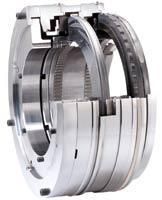How to prevent the loss of lube oil in gas seal systems
In order to ensure safety and reliability of gas seals, the system must be properly specified and designed.

Listed below are typical gas seal system applications in use today.
Low/medium pressure applications – dry air or inert gas
This system, incorporating a single dry gas seal, is identical to that of a liquid pump flush system incorporating relatively clean fluid that meets the requirements of the seal in terms of temperature and pressure. This system takes the motive fluid from the discharge of the compressor through dual filters (ten microns or less) incorporating a differential pressure gauge and proportions equal flow through flow meters to each seal on the compressor.
Compressors are usually pressure balanced such that the pressure on each end is approximately equal to the suction pressure of the compressor. The clean gas then enters the seal chamber and has two main paths:
- Through the internal labyrinth back to the compressor. Note that the majority of supplied gas takes this path for cooling purposes (99 percent).
- Across the seal face and back to either the suction of the compressor or to vent.
Since the gas in this application is inert, it can be vented directly to the atmosphere or can be put back to the compressor suction. It must be noted, however, that this port is next to the journal bearing. Therefore a means of positively preventing entry of lube oil into this port must be provided in order to prevent the loss of lube oil or prevent the ingestion of lube oil into the compressor if this line is referenced back to the compressor suction.
A suitable design must be incorporated for this bushing. Typically called a disaster bushing, it serves the dual purpose of isolating the lube system from the seal system, and providing a means of minimizing the leakage of process fluid into the lube system in the event of a gas seal failure. In this system, a pressure switch upstream of an orifice in a vent line is used as an alarm and a shutdown to monitor flow. This switch uses the concept of an equivalent vessel in that increased seal leakage will increase the rate of supply versus demand flow in the equivalent vessel (pipe) and result in a higher pressure.
When a high flow is reached, the orifice and pressure switch setting are thus sized and selected to alarm and shut down the unit if necessary. As in any system, close attention to changes in operating parameters is required. Flow meters must be properly sized and kept clean, so that relative changes in the flows can be detected in order to adequately plan for seal maintenance.
High pressure applications
In this application, for pressures in excess of 6,895 kPa (1,000 psi), a tandem seal arrangement or series seal arrangement is usually used. Since failure of the inner seal would cause significant upset of the seal system, and large amounts of gas to escape to the atmosphere, a backup seal is employed. For present designs, up to 17,250 kPa (2500 psi), double tandem seals are proven and used.
The arrangement is essentially the same as low/medium pressure applications except that a backup seal is used in place of the disaster bushing. Most designs still incorporate a disaster bushing between the backup seal and the bearing cavity, known these days as the barrier seal. Attention in this design must be given to control of the inter-stage pressure between the primary and backup seal.
Experience has shown that low differentials across the backup seal can significantly decrease its life. As in the case of liquid seals, a minimum pressure in the cavity between the seals of 172-207 kPa (25-30 psi) is usually specified. This is achieved by properly sizing the orifice in the vent or reference back to the suction to ensure this pressure is maintained. All instrumentation and filtration are identical to that of the previous system.